MetricMoose
New Member
Hey everyone,
I thought I'd share my efforts to modify an off-the-shelf Hyundai HY3500P generator from Princess Auto for use at an off-grid wireless ISP tower site.
A couple years ago, my employer acquired a small wireless ISP network to expand into one region in Northern Ontario. This network has an off-grid tower site that was pretty critical to one region of the network. The power draw is about 50W continuously from a router and some wireless devices, it has eight 325W panels, one small wind turbine that was probably mounted a bit too low to be effective, and 210AH of SLA batteries wired in two strings of 48V. LiFePO4 would be great, but temperatures get down to -30°C in an unheated shack. Six of the panels are connected to the Outback FM60 MPPT with 3 sets of 2 panels in series. A second MPPT controller, a Tristar 60, has another 2 panels facing another direction.
This setup worked flawlessly during the spring, summer and fall but was a major headache over the last two winters. The short days with a lot of overcast skies and snowfall covering the panels meant we had often had to take a kilometer hike on snowshoes up the small mountain to clear off the panels and start a small Honda generator to power a Meanwell 1000W 48V battery charger. Our snowmobile had a difficult time with the deep snow and the narrow, densely treed path, and you'd still have to hike the last 150 meters regardless.
In an effort to reduce the amount of visits to the site, we started looking into some remote start generator options. Locally, we couldn't find anything that fit our situation. We looked into some diesel options and they were expensive, large and would be extremely difficult to lug into the site. Propane posed the same challenge, refueling would involve dragging tanks up and down the hill by hand on the last few steep parts. We are also looking to abandon the location due to a number of other factors besides power (The tower itself is very light duty and would be difficult to replace, the location isn't great for RF with all the targeted sites being within one narrow azimuth causing overlap in channels), so we also needed something that could be reused elsewhere and would not be difficult to install/remove.
Looking through other local sources, we found a good candidate generator for $1000 CAD, the Hyundai HY3500P. It was compact, had electric start, automatic choke and some wireless fobs for starting and stopping, along with a rocker switch for the same features. Unfortunately the controller stops listening to the fobs after 48 hours, but knowing that you could start and stop it electronically gave me hope that we could hook into the rocker switch.
We combined it with a few other parts we obtained locally, such as a 45 litre marine gas tank, a larger starter battery (going from 7AH to 28AH), a 5W solar battery tender and a few misc components to extend the fuel line. For attaching the fuel tank, we removed the OEM fuel shutoff and used a coupler to tie it into a marine fuel line with a primer bulb back to the tank.
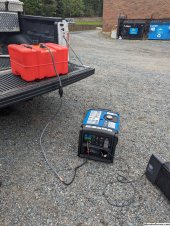
I took off the front control panel on the generator and ran wires to the back of the generator's "Start / On / Off" switch. "On" is the middle, normal position, with start and stop options positions actually closing contacts. I also ran wires to the Eco Mode switch to control that remotely. I had some female quick disconnect terminals with an extra male tab on them, so I was able to connect my new wires without splicing into the harness on the generator.
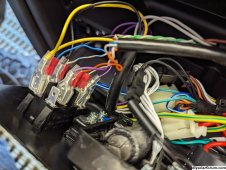
For remote control, we had a Packetflux Site Monitor Base II on the shelf, it allows you to control and monitor various inputs and outputs through HTTP in a web browser or by using SNMP. It also integrated well with the other Packetflux wireless ISP products for PoE and GPS sync. We had a "Temperature Control" addon module that just gives it a couple temp sensors and some relay outputs, so I hooked those into the new wires that I ran to the generator control panel. I also used a 12V relay, triggered by a 12V AC power brick connected to a the generator's AC output so I could get the running status of the generator. The Sitemonitor is powered directly by the battery bank, so I can get the voltage of the batteries from that input as well. Excuse the relay wires being stripped way too far, I had a coworker helping me install everything and had him redo it later when I noticed them being long enough to accidentally short...
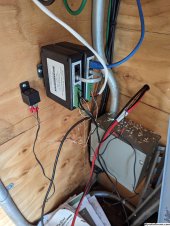
After this, our construction team built a platform for the tank and generator to keep it off the ground to avoid it from getting buried in the multiple feet of snow that will accumulate up there.

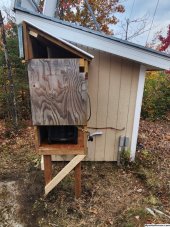
I also wrote a small web app on our internal network that allows us to VPN in and control it remotely. I wrote it in PHP and it sends/queries the SNMP server on the Packetflux Sitemonitor. I'm also using FFMPEG to grab a still from our camera system so you can see if the panels are covered at a glance. I'm not much of a front-end HTML/CSS/Javascript guy, so I did have ChatGPT help out a bit to save me figuring out how to nicely query my backend code and making it look passable.
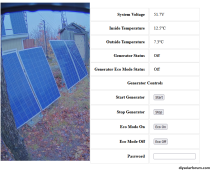
So far, before winter, it seems to be working okay. We've done a few 1-2 hour test runs and it seems to run things just fine. One issue is that it can take about 4-8 start attempts to (presumably) draw in fuel and get running after it has been sitting for a while. The electric start button will cycle the starter motor for a fixed 2 second attempt no matter how long you hold the button, so you just have to repeat the start command until you see it kick in. I'm not the most savvy with small engines, but the advice I got was that it would likely work better with a small fuel pump and a pressure regulator. Since we quadrupled the starter battery size and have the solar battery tender, my hope is we can get away with doing a bit of extra cranking when needed.
The last other upgrade we'll be doing before the snow hits is replacing the eight ~3 year old 105AH SLA batteries with new 140AH batteries to give us a little extra capacity. The current batteries could be recycled into some DC UPS systems after testing their capacity.
I will have to post an update during the winter with how it works out. My goal is to at least halve the amount of times we go up there this season. At the absolute minimum, having a larger fuel tank (and some stashed jerry cans) up there means we don't have to lug up fuel, and being able to stop the generator when the batteries are at a decent level means we'll consume less of it compared to just leaving the generator to run dry every time.
I thought I'd share my efforts to modify an off-the-shelf Hyundai HY3500P generator from Princess Auto for use at an off-grid wireless ISP tower site.
A couple years ago, my employer acquired a small wireless ISP network to expand into one region in Northern Ontario. This network has an off-grid tower site that was pretty critical to one region of the network. The power draw is about 50W continuously from a router and some wireless devices, it has eight 325W panels, one small wind turbine that was probably mounted a bit too low to be effective, and 210AH of SLA batteries wired in two strings of 48V. LiFePO4 would be great, but temperatures get down to -30°C in an unheated shack. Six of the panels are connected to the Outback FM60 MPPT with 3 sets of 2 panels in series. A second MPPT controller, a Tristar 60, has another 2 panels facing another direction.
This setup worked flawlessly during the spring, summer and fall but was a major headache over the last two winters. The short days with a lot of overcast skies and snowfall covering the panels meant we had often had to take a kilometer hike on snowshoes up the small mountain to clear off the panels and start a small Honda generator to power a Meanwell 1000W 48V battery charger. Our snowmobile had a difficult time with the deep snow and the narrow, densely treed path, and you'd still have to hike the last 150 meters regardless.
In an effort to reduce the amount of visits to the site, we started looking into some remote start generator options. Locally, we couldn't find anything that fit our situation. We looked into some diesel options and they were expensive, large and would be extremely difficult to lug into the site. Propane posed the same challenge, refueling would involve dragging tanks up and down the hill by hand on the last few steep parts. We are also looking to abandon the location due to a number of other factors besides power (The tower itself is very light duty and would be difficult to replace, the location isn't great for RF with all the targeted sites being within one narrow azimuth causing overlap in channels), so we also needed something that could be reused elsewhere and would not be difficult to install/remove.
Looking through other local sources, we found a good candidate generator for $1000 CAD, the Hyundai HY3500P. It was compact, had electric start, automatic choke and some wireless fobs for starting and stopping, along with a rocker switch for the same features. Unfortunately the controller stops listening to the fobs after 48 hours, but knowing that you could start and stop it electronically gave me hope that we could hook into the rocker switch.
We combined it with a few other parts we obtained locally, such as a 45 litre marine gas tank, a larger starter battery (going from 7AH to 28AH), a 5W solar battery tender and a few misc components to extend the fuel line. For attaching the fuel tank, we removed the OEM fuel shutoff and used a coupler to tie it into a marine fuel line with a primer bulb back to the tank.

I took off the front control panel on the generator and ran wires to the back of the generator's "Start / On / Off" switch. "On" is the middle, normal position, with start and stop options positions actually closing contacts. I also ran wires to the Eco Mode switch to control that remotely. I had some female quick disconnect terminals with an extra male tab on them, so I was able to connect my new wires without splicing into the harness on the generator.

For remote control, we had a Packetflux Site Monitor Base II on the shelf, it allows you to control and monitor various inputs and outputs through HTTP in a web browser or by using SNMP. It also integrated well with the other Packetflux wireless ISP products for PoE and GPS sync. We had a "Temperature Control" addon module that just gives it a couple temp sensors and some relay outputs, so I hooked those into the new wires that I ran to the generator control panel. I also used a 12V relay, triggered by a 12V AC power brick connected to a the generator's AC output so I could get the running status of the generator. The Sitemonitor is powered directly by the battery bank, so I can get the voltage of the batteries from that input as well. Excuse the relay wires being stripped way too far, I had a coworker helping me install everything and had him redo it later when I noticed them being long enough to accidentally short...

After this, our construction team built a platform for the tank and generator to keep it off the ground to avoid it from getting buried in the multiple feet of snow that will accumulate up there.


I also wrote a small web app on our internal network that allows us to VPN in and control it remotely. I wrote it in PHP and it sends/queries the SNMP server on the Packetflux Sitemonitor. I'm also using FFMPEG to grab a still from our camera system so you can see if the panels are covered at a glance. I'm not much of a front-end HTML/CSS/Javascript guy, so I did have ChatGPT help out a bit to save me figuring out how to nicely query my backend code and making it look passable.

So far, before winter, it seems to be working okay. We've done a few 1-2 hour test runs and it seems to run things just fine. One issue is that it can take about 4-8 start attempts to (presumably) draw in fuel and get running after it has been sitting for a while. The electric start button will cycle the starter motor for a fixed 2 second attempt no matter how long you hold the button, so you just have to repeat the start command until you see it kick in. I'm not the most savvy with small engines, but the advice I got was that it would likely work better with a small fuel pump and a pressure regulator. Since we quadrupled the starter battery size and have the solar battery tender, my hope is we can get away with doing a bit of extra cranking when needed.
The last other upgrade we'll be doing before the snow hits is replacing the eight ~3 year old 105AH SLA batteries with new 140AH batteries to give us a little extra capacity. The current batteries could be recycled into some DC UPS systems after testing their capacity.
I will have to post an update during the winter with how it works out. My goal is to at least halve the amount of times we go up there this season. At the absolute minimum, having a larger fuel tank (and some stashed jerry cans) up there means we don't have to lug up fuel, and being able to stop the generator when the batteries are at a decent level means we'll consume less of it compared to just leaving the generator to run dry every time.


